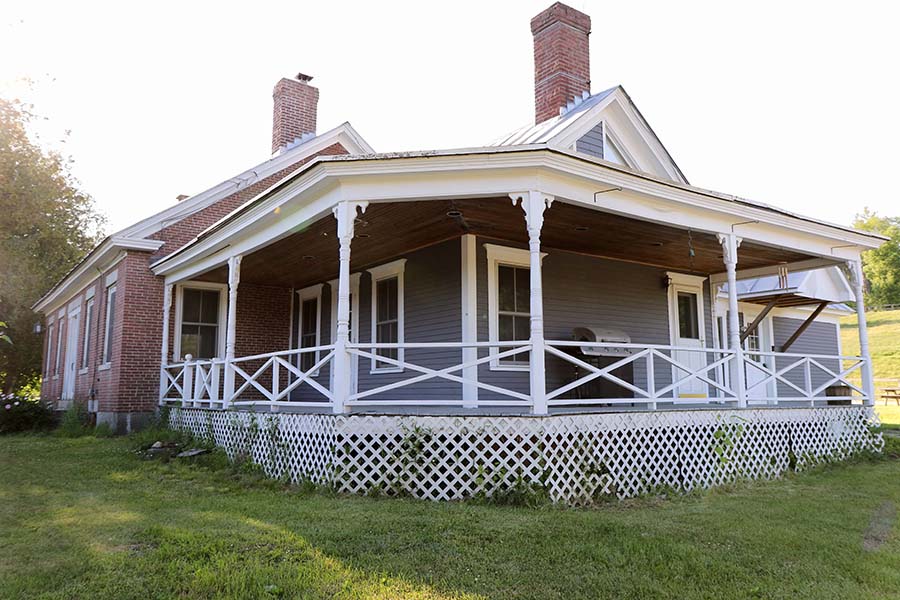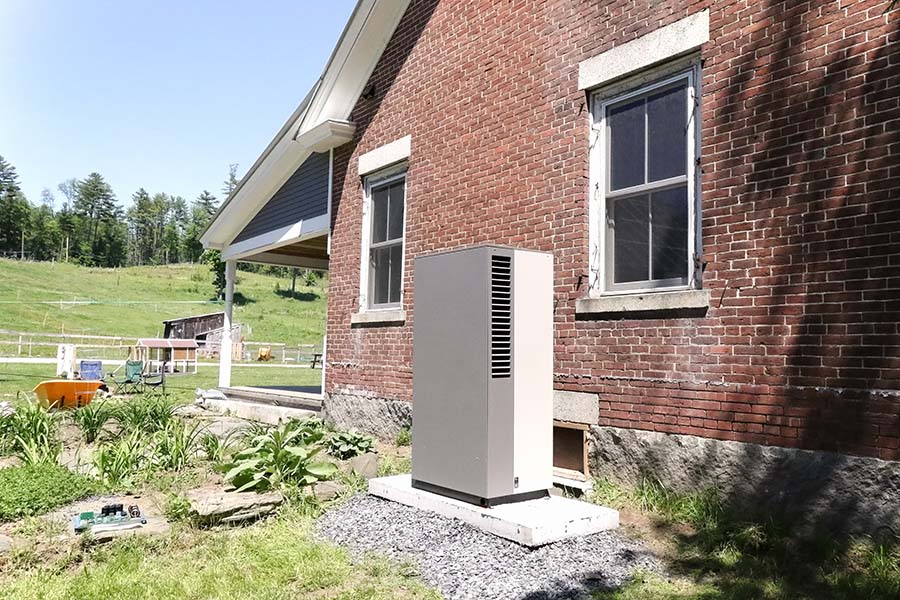Johnathan Matthew and Tracy Roux joined the ranks of energy-efficient, fossil fuel-free Airbnb owners in the state of Vermont.
The farmhouse, on 50 acres near Plainfield, was originally constructed in 1791 and added to extensively in 1827. Matthew purchased the property (listed on the National Register of Historic Places) in 1997. When he bought it, it was a gentleman’s farm and he turned it into a horse farm.

HISTORY: Built in 1791, the farmhouse is now one of the few fossil fuel-free Airbnb properties in Vermont. (Courtesy of Dan Vastyan)
“Most of the horses are now gone, and it’s an operating Airbnb that stays booked solid, even through the pandemic,” Matthew said.
The 2,100-square-foot brick farmhouse has undergone many efficiency upgrades since 1997: a new roof, solar panels, modern wiring, insulation in the roof and basement, and energy-efficient windows throughout. The final component was an HVAC system upgrade from its existing oil-fired furnace.
Matthew and Jonathan Lloyd, comfort advisor and project manager for Lloyd Plumbing, Heating and Gas Services LLC, held several meetings to discuss the best options for the historical home.
From early on, the primary objective was to remain as environmentally friendly as possible and to tap renewable energy.
“The existing 13.8 kW solar array was a great start to achieving that goal,” said Lloyd. “It was initially sized to support the electrical load of an operating horse farm and a house full of kids.” Now, without horses and kids, the photovoltaic system is oversized.
“Matthew and I discussed the use of a pellet boiler, but this didn’t address the need for air conditioning,” he continued.
He also considered the use of ductless heat pumps, but he and Roux preferred a radiant heat system for premium comfort.
Beta Test Air-to-Water Heat Pump

HOT HYDRONIC: Taco’s pre-release System M air-to-water heat pump is installed at the farmhouse, supplying hot water to both the home’s large indirect water heater and its main hydronic panel. (Courtesy of Dan Vastyan)
Lloyd explained to Matthew that Mark Chafee, vice president of governmental relations and sustainability at Taco Comfort Solutions, had approached Efficiency Vermont for assistance in identifying an ideal application as a Beta test site for Taco’s air-to-water heat pump system.
Taco’s System M heat pump is an all-electric turnkey air-to-water-heat pump system that capably provides heating, cooling, and domestic hot water to a residence with zero fossil fuel emissions. Much like a conventional unitary heat pump or a ductless mini split, the system includes an indoor and an outdoor unit.
The outdoor unit is a stylish, quiet condensing unit powered by a radically efficient variable-speed inverter and fan combination. The mating indoor unit houses a complete package of pumps, controls, and piping accessories ready to send chilled or hot water to all types of HVAC heating and cooling distribution systems. This can include hydronic coils for use in ductwork, convectors, radiators, unit heaters, and radiant tubing, giving contractors, architects, and homeowners a vast array of options for comfort, architectural flexibility, and energy efficiency.

SLEEK: The outdoor unit is sleek and weatherproof. (Courtesy of Dan Vastyan)
“Our air-to-water heat pump incentive program began in April of 2019,” said Brian Sweeny, supply chain account manager at Efficiency Vermont. “Since then, we’ve supported dozens of installations. The biggest hurdle is contractor familiarity with the systems, or lack thereof. That results in higher prices for the systems, putting them out of reach for many Vermonters. Whatever we can do to reduce the complexity should help bring down the cost and increase installations.”
Like many modern appliances, the system can be controlled through a mobile app.
“This is the Tesla of the residential HVAC world,” said Chaffee. “In that respect, it’s similar to a geothermal system, though without the expense and disturbance of drilling or trenching a ground loop. It will appeal to homeowners who’re interested in minimizing their environmental impact and eliminating fossil fuel consumption from their property. It will also be of interest to consumers who understand the comfort advantages of a water-based hydronic heating and cooling system.”
Matthew and Roux planned to fully capitalize on the latter.
Road to Comfort
In addition to providing domestic hot water, the new heat pump system provides chilled and hot water to different radiation components. Matthew was adamant about providing in-floor radiant heat for the guests at the Airbnb, and took it upon himself to install radiant tubing below the floor on the ground floor of the house.
From the basement, Matthew stapled half-inch hydronic tubing to the underside of the original wood flooring. He maintained 4-inch spacing between the tubing, and heavily insulated from below. With supply water coming from the heat pump, warmth penetrates the thick wooden boards and creates a very comfortable living space.
Before the retrofit, the upstairs of the house had been extremely uncomfortable during the cooling season. In each of the bedrooms — two upstairs and one downstairs — Lloyd Plumbing & Heating installed fan coil units for heating and air conditioning.
“Not counting the domestic hot water load, the home needs 60,000 BTUs of heating capacity at design conditions,” said Lloyd. “The heat pump is rated for 44,000 BTUs. In addition to replacing the old oil boiler, the new heat pump has also replaced the existing propane water heater. Even when the house is full of guests, there has always been ample hot water for showers.”
Renewable Backup Heat
Before deciding to install the heat pump, Matthew and Roux had considered the use of a biomass system to heat the home — looking most closely at a wood pellet boiler. They liked the concept of using a renewable solid fuel so much that they decided to install one as a secondary source of backup heat. On the coldest of Vermont nights, when that backup heat and extra BTUs are needed, they can rely on the pellet boiler to keep the house warm.
“Using a backup pellet boiler allows us to remain 100% renewable, and the system we purchased is state-of-the-art,” said Matthew.
Lloyd Plumbing and Heating is also one of the leading installers of Pellergy Wood Pellet Boilers in North America. Working with Andy Boutin of Pellergy LLC, Lloyd Plumbing and Heating suggested a Pellergy Alpha A60, manufactured by Windhager. Pellergy provided the technical support and assistance to integrate the backup/peak loading boiler into the thermal loop and heat pump controls to provide an integrated system.
“Matthew’s boiler has a 52,000 BTU/H output and runs at 86% sustained efficiency,” said Boutin, general manager at Pellergy. “He can purchase locally-sourced bulk pellets that are delivered directly to his bin.”
Owner, Lloyd Plumbing & Heating and Gas Services
Comfort and Rebates
“Old brick homes like this one always present challenges when installing central heating and cooling systems,” said Peter Lloyd, owner of Lloyd Plumbing & Heating. “These challenges were somewhat alleviated because we didn’t need to install ductwork throughout the old house. The heat pump and pellet boiler combined with radiant floors and fan coils made for an unbeatable combination while trying to achieve the homeowner’s net-zero energy goal.
Matthew received a $6,000 rebate for installation of the pellet boiler: $3,000 from Efficiency Vermont and $3,000 from the Vermont Clean Energy Development Fund. Installation of the air-to-water heat pump would have qualified for an additional $1,000 per ton of installed capacity, had it not been a beta test unit.
“This [technology] creates an opportunity for homeowners to increase their sustainability in a cool climate. As a fully-contained package, it’s ideal for converting from a fossil fuel boiler or furnace,” said Peter Lloyd.


Report Abusive Comment